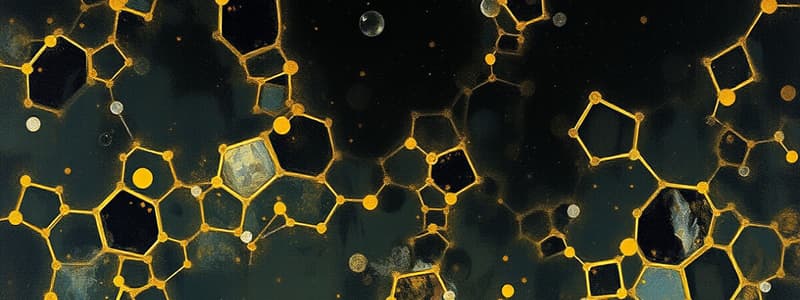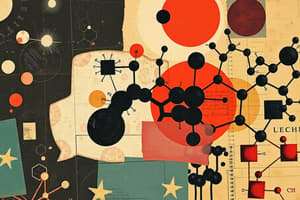Podcast
Questions and Answers
Which subatomic particle primarily affects the mass of an atom?
Which subatomic particle primarily affects the mass of an atom?
- Electrons
- Positrons
- Protons (correct)
- Neutrons (correct)
Which type of bond is characterized as being the strongest among ionic, covalent, and hydrogen bonds?
Which type of bond is characterized as being the strongest among ionic, covalent, and hydrogen bonds?
- Hydrogen bond
- Covalent bond (correct)
- Metallic bond
- Ionic bond
What defines the reactivity of an atom in relation to its electron shells?
What defines the reactivity of an atom in relation to its electron shells?
- The size of the nucleus
- The total number of protons
- The presence of unpaired electrons in the valence shell (correct)
- The number of neutrons in the nucleus
What is the correct definition of a valence shell?
What is the correct definition of a valence shell?
Which element's atomic structure allows it to form a diverse range of organic compounds?
Which element's atomic structure allows it to form a diverse range of organic compounds?
Which of the following statements about ionic and covalent bonds is accurate?
Which of the following statements about ionic and covalent bonds is accurate?
What primarily dictates how an atom will react chemically with other atoms?
What primarily dictates how an atom will react chemically with other atoms?
Which particle encircles the nucleus at specified energy levels?
Which particle encircles the nucleus at specified energy levels?
What distinguishes polar covalent bonds from nonpolar covalent bonds?
What distinguishes polar covalent bonds from nonpolar covalent bonds?
How does the number of electrons in an atom's valence shell most significantly impact its chemical behavior?
How does the number of electrons in an atom's valence shell most significantly impact its chemical behavior?
Which particle determines the atomic number of an element?
Which particle determines the atomic number of an element?
What distinguishes a molecule from a compound?
What distinguishes a molecule from a compound?
What is an ion?
What is an ion?
Which of the following represents atomic mass?
Which of the following represents atomic mass?
How are isotopes of an element different from each other?
How are isotopes of an element different from each other?
What defines a pure substance?
What defines a pure substance?
Which statement about elements is correct?
Which statement about elements is correct?
What happens when an atom gains an electron?
What happens when an atom gains an electron?
Which of the following does not describe a characteristic of matter?
Which of the following does not describe a characteristic of matter?
Which property differentiates compounds from ions?
Which property differentiates compounds from ions?
Which of the following best describes the role of proteins in living organisms?
Which of the following best describes the role of proteins in living organisms?
Which scientific fields contribute to the understanding of biochemistry?
Which scientific fields contribute to the understanding of biochemistry?
In the context of biochemistry, which process is primarily associated with the function of enzymes?
In the context of biochemistry, which process is primarily associated with the function of enzymes?
Which of the following statements about biochemistry is false?
Which of the following statements about biochemistry is false?
What is NOT a typical function of proteins in biological systems?
What is NOT a typical function of proteins in biological systems?
Which biochemistry-related field would most likely study the effects of substances on cellular processes?
Which biochemistry-related field would most likely study the effects of substances on cellular processes?
What is a key characteristic of enzymes?
What is a key characteristic of enzymes?
Which of the following best illustrates how biochemistry interrelates with cell biology?
Which of the following best illustrates how biochemistry interrelates with cell biology?
How does nutrition relate to biochemistry?
How does nutrition relate to biochemistry?
What does the application of biochemistry primarily focus on?
What does the application of biochemistry primarily focus on?
Flashcards are hidden until you start studying
Study Notes
Composition of Matter
- Matter is defined as anything that has mass and occupies space, made up of elements.
- Elements are pure substances that cannot be broken down by ordinary chemical means.
- Atoms are the smallest unit of an element, maintaining the element’s properties.
- Subatomic particles include protons, neutrons, and electrons.
- Ions are atoms that carry a charge due to the gain or loss of electrons.
- Molecules consist of two or more atoms bonded together.
- Compounds can form from atoms of the same or different elements.
- Atomic number refers to the number of protons in an atom.
- Atomic mass is the sum of protons and neutrons.
- Isotopes are variations of an element that differ in the number of neutrons.
Chemical Bonding
- Ionic bonding involves the transfer of electrons, resulting in the formation of cations (positively charged ions) and anions (negatively charged ions).
- Covalent bonding involves the sharing of electron pairs between atoms; can be polar (unequal sharing) or nonpolar (equal sharing).
- Hydrogen bonds are weaker interactions compared to ionic and covalent bonds.
- The electron shell represents energy levels where electrons orbit around the nucleus.
- The valence shell is the outermost electron shell and determines the atom's reactivity.
- The number of electrons in the valence shell is crucial for predicting chemical reactivity.
Organic Compounds
- Organic compounds primarily consist of carbon (C) atoms covalently bonded to hydrogen (H), oxygen (O), nitrogen (N), and other elements.
- Carbon skeletons can form diverse structures by sharing electrons with other carbon atoms.
Relevance of Biochemistry in Medicine
- Biochemistry contributes to understanding health and disease across several fields, including:
- Cell Biology
- Immunology
- Pharmacology
- Toxicology
- Pathology
- Nutrition
- It applies principles from chemistry and biology to study processes within living organisms, both in healthy and diseased states.
Functions of Biomolecules
- Proteins serve various roles such as:
- Enzymatic activity (catalysts for biochemical reactions)
- Transporting molecules across cell membranes
- Providing structural support in cells and tissues
- Regulating processes within the cell.
Studying That Suits You
Use AI to generate personalized quizzes and flashcards to suit your learning preferences.



